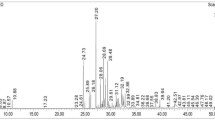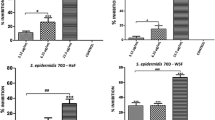Abstract
Purpose
The present study aimed to examine in vitro anticancer and apoptotic effects of the 80% ethanolic extract of Hymenodictyon floribundum and isolated compounds on A549 human lung cancer cell lines. Furthermore, isolated compounds and crude extract were investigated for their antimicrobial activity against Aspergillus niger, Pseudomonas aeruginosa, Bacillus subtilis, Escherichia coli, Candida albicans, and Staphylococcus aureus.
Methods
The anticancer activity was examined by trypan blue exclusion and MTT assays. Flow cytometry was used to assess apoptosis using the Annexin V-FITC/PI technique, the antimicrobial activity was assessed by using Broth microdilution method against six pathogenic microbes. The GC–MS, 1H NMR, 13C NMR, and mass spectral data were used to elucidate the structure of isolated compounds.
Results
The study resulted in the isolation of two compounds, 7-Hydroxy-6- methoxycoumarin (A) and 2,2,4-Trimethyl-3-(3,8,12,16-tetramethyl-heptadeca-3,7,11,15-tetraenyl)-cyclohexanol (K). The compound A and K inhibited the growth of A549 lung cancer cell lines with IC50 values of 77.56 µg/mL and 92.13 µg/mL, respectively. The anticancer effects of compounds A and K were due to early and late apoptotic cell death induction. Compounds A and K exhibited potential antimicrobial activity against all microbes tested. The highest antimicrobial activity was shown by compound A against S. aureus with a minimum inhibitory concentration (MIC) of 62.5 µg/mL.
Conclusion
These findings provide evidence that the stem bark extract of H. florubundum contains compounds with both anticancer and antimicrobial activity. The isolated compounds were found to possess antimicrobial activity and inhibit the growth of A549-Human lung cancer cells by inducing apoptosis.










Similar content being viewed by others
Availability of Data and Materials
Data will be made available on request.
Abbreviations
- DCM:
-
Dichloromethane
- DMSO:
-
Dimethyl sulphoxide
- GC:
-
Gas chromatography
- GC–MS:
-
Gas chromatography-mass spectrometer
- ICCR:
-
Indian council for cultural relations
- MTT:
-
3-(4, 5-Dimethylthiazol-2-yl)-2, 5-diphenyltetrazolium bromide
- MIC:
-
Minimum inhibitory concentration
- MBC:
-
Minimum bactericidal concentration
- MFC:
-
Minimum fungicidal concentration
- NMR:
-
Nuclear magnetic resonance
- NCCS:
-
National centre for cell science
- O.D:
-
Optic density
- P.E:
-
Petroleum ether
- PI:
-
Propidium iodide
- PBS:
-
Phosphate buffer solution
- SD:
-
Standard deviation
- TLC:
-
Thin Layer Chromatography
- TSB:
-
Trypticase Soy Broth
- UV:
-
Ultraviolet light
References
Kooti W, Servatyari K, Behzadifar M, Asadi-Samani M, Sadeghi F, Nouri B, Zare Marzouni H (2017) Effective medicinal plant in cancer treatment, part 2: review study. J Evid-Based Complement Alternat Med 22(4):982–995. https://doi.org/10.1177/2156587217696927
Xiang D, Hu S, Mai T, Zhang X, Zhang L, Wang S et al (2022) Worldwide cancer statistics of adults over 75 years old in 2019: a systematic analysis of the global burden of disease study 2019. BMC Public Health 22(1):1–14. https://doi.org/10.1186/s12889-022-14412-1
Chhikara BS & Parang K (2022) Chemical Biology Letters Global Cancer Statistics 2022: the trends projection analysis. Chem Biol Lett 2023(1):451. https://pubs.thesciencein.org/cbl
Fahmy SA, Brüßler J, Alawak M, El-Sayed MMH, Bakowsky U, Shoeib T (2019) Chemotherapy based on supramolecular chemistry: a promising strategy in cancer therapy. Pharmaceutics 11(6):1–16. https://doi.org/10.3390/pharmaceutics11060292
Tian Q, Wang L, Sun X, Zeng F, Pan Q, Xue M (2019) Scopoletin exerts anticancer effects on human cervical cancer cell lines by triggering apoptosis, cell cycle arrest, inhibition of cell invasion and PI3K/AKT signalling pathway. J BUON 24(3):997–1002
Ibrahim B, Sowemimo A, Spies L, Koekomoer T, Van De Venter M, Odukoya OA (2013) Antiproliferative and apoptosis inducing activity of Markhamia tomentosa leaf extract on HeLa cells. J Ethnopharmacol 149(3):745–749. https://doi.org/10.1016/j.jep.2013.07.040
Roy A, Ahuja S & Bharadvaja N (2017) Anticancer activity of medicinal plants Actaea racemosa. iMedPub J 1(2019):1–5
Khairunnisa K, Karthik D (2014) Evaluation of in-vitro apoptosis induction, cytotoxic activity of Hymenodictyon excelsum (Roxb) Wall in Dalton’s lymphoma ascites (DLA) and Lung fibroblast—Mouse L929 cell lines. J Appl Pharm Sci 4(08):11–17. https://doi.org/10.7324/JAPS.2014.40803
Marealle AI, Innocent E, Andrae-Marobela K, Qwarse M, Machumi F, Nondo RRSO et al (2022) Safety evaluation and bioassay-guided isolation of antimycobacterial compounds from Morella salicifolia root ethanolic extract. J Ethnopharmacol 296(June):115501. https://doi.org/10.1016/j.jep.2022.115501
Hilonga S, Otieno JN, Ghorbani A, Pereus D, Kocyan A, de Boer H (2019) Trade of wild-harvested medicinal plant species in local markets of Tanzania and its implications for conservation. S Afr J Bot 122:214–224. https://doi.org/10.1016/j.sajb.2018.08.012
Kebebew M & Mohamed E (2017) Indigenous knowledge on use of medicinal plants by indigenous people of Lemo District, Hadiya Zone, Southern Ethiopia. 124 Int J Herbal Med 5(4):124–135. https://www.florajournal.com/archives/2017/vol5issue4/PartB/6-3-17-801.pdf
Fernandes NAF, Canelo LIN, De Mendonça DIMD, De Mendonça AJG (2015) Acetylcholinesterase inhibitory activity of extracts from angolan medicinal plants. Int J Pharmacogn Phytochem Res 7(4):768–776
Jiao C, Xie YZ, Yang X, Li H, Li XM, Pan HH et al (2013) Anticancer activity of Amauroderma rude. PLoS One. https://doi.org/10.1371/journal.pone.0066504
Mohamed A (2017) Evaluation of antimicrobial activity of different solvent extracts of Saussurea Lappa. World J Pharm Pharmaceut Sci 4(2):12–18. https://doi.org/10.20959/wjpps20179-9868
Gupta D, Dubey J, Kumar M (2016) Phytochemical analysis and antimicrobial activity of some medicinal plants against selected common human pathogenic microorganisms. Asian Pacific J Trop Dis 6(1):15–20. https://doi.org/10.1016/S2222-1808(15)60978-1
Romulo A, Zuhud EAM, Rondevaldova J, Kokoska L (2018) Screening of in vitro antimicrobial activity of plants used in traditional indonesian medicine. Pharm Biol 56(1):287–293. https://doi.org/10.1080/13880209.2018.1462834
Naz R, Ayub H, Nawaz S, Islam ZU, Yasmin T, Bano A et al (2017) Antimicrobial activity, toxicity and anti-inflammatory potential of methanolic extracts of four ethnomedicinal plant species from Punjab, Pakistan. BMC Complement Altern Med 17(1):1–13. https://doi.org/10.1186/s12906-017-1815-z
Tailulu A, Li M, Ye B, Al-qudaimi R, Cao F, Liu W, Shi P (2022) Antimicrobial and anticancer activities of Hainan dry noni fruit alcoholic extracts and their novel compounds identification using UPLC-Q-Exactive Obitrap-MS/MS. J Pharm Biomed Anal 220(August):114989. https://doi.org/10.1016/j.jpba.2022.114989
Vijayan A (2017) Share Your Innovations through JACS directory journal of natural products and resources phytochemical analysis of Elaeocarpus blascoi Weibel using gas chromatography-mass spectroscopy. J Nat Prod Resour 3(2):125–129. http://www.jacsdirectory.com/jnpr
Ugochi N, Ogugofor MO (2019) Gas Chromatography-Mass Spectrometry analysis of bioactive chemical compounds of ethyl acetate fraction of Lantana camara Leaf: a potential folklore medicinal plant. Int J Biol Pharm Allied Sci. https://doi.org/10.31032/ijbpas/2019/8.10.4819
Demirgan R, Karagöz A, Pekmez M, Önay-Uçar E, Artun FT, Gürer Ç, Mat A (2016) In vitro anticancer activity and cytotoxicity of some papaver alkaloids on cancer and normal cell lines. Afr J Tradit Complement Altern Med 13(3):22–26. https://doi.org/10.4314/ajtcam.v13i3.3
Moradi M, Karimi A, Alidadi S (2016) In vitro antiproliferative and apoptosis-inducing activities of crude ethyle alcohole extract of Quercus brantii L. acorn and subsequent fractions. Chin J Nat Med 14(3):196–202. https://doi.org/10.1016/S1875-5364(16)30016-4
Mogana R, Wiart C (2013) Potential of Scopoletin isolated from Canarium patentinervium Miq. (Burseraceae Kunth). Evid-Based Complement Altern Med 2013:1–6
Chakraborty M, Karmakar I & Haldar PK (2016) Cytotoxic and anti proliferative activity of Hymenodictyon excelsum in ehrlich ascites carcinoma bearing mice: in vitro and in vivo. (March) 3–10
Kurdekar RR, Hegde GR, Kulkarni MV & Mulgund GS (2014) International Journal of Pharmaceutical and Isolation and Characterization of Scopoletin—an Anticancer Compound from the Bark of Hymenodictyon Obovatum Wall. 3(6):469–471
Adams M, Efferth T, Bauer R (2006) Activity-guided isolation of scopoletin and isoscopoletin, the inhibitory active principles towards CCRF-CEM leukaemia cells and multi-drug resistant CEM/ADR5000 cells, from Artemisia argyi. Planta Med 72(9):862–864. https://doi.org/10.1055/s-2006-947165
Barreiro Arcos ML, Cremaschi G, Werner S, Coussio J, Ferraro G, Anesini C (2006) Tilia cordata Mill. Extracts and scopoletin (isolated compound): differential cell growth effects on lymphocytes. Phytother Res 20(1):34–40. https://doi.org/10.1002/ptr.1798
Nelson V, Sahoo NK, Sahu M, Sudhan H, Pullaiah CP (2020) In vitro anticancer activity of Eclipta alba whole plant extract on colon cancer cell. BMC Complement Med Ther 9:1–8
Kaigongi MM, Lukhoba CW, Yaouba S, Makunga NP, Githiomi J, Yenesew A (2020) In vitro antimicrobial and antiproliferative activities of the root bark extract and isolated chemical constituents of Zanthoxylum paracanthum kokwaro (Rutaceae). Plants 9(7):1–15. https://doi.org/10.3390/plants9070920
Meilawati L, Dewi RM, Tasfiyati AN, Septama AW, Antika LD (2023) Scopoletin: anticancer potential and mechanism of action. Asian Pac J Trop Biomed 13(October 2022):1–8. https://doi.org/10.4103/2221-1691.367685
Aldakheel RK, Rehman S, Almessiere MA, Khan FA, Gondal MA, Mostafa A, Baykal A (2020) Bactericidal and in vitro cytotoxicity of Moringa oleifera seed extract and its elemental analysis using laser-induced breakdown spectroscopy. Pharmaceuticals 13(8):1–18. https://doi.org/10.3390/ph13080193
Faruque MO, Ankhi UR, Kamaruzzaman M, Barlow JW, Zhou B, Hao J et al (2019) Chemical composition and antimicrobial activity of Congea tomentosa, an ethnomedicinal plant from Bangladesh. Ind Crop Prod 141(August):111745. https://doi.org/10.1016/j.indcrop.2019.111745
Ayele TT, Gurmessa GT, Abdissa Z, Kenasa G, Abdissa N (2022) Oleanane and stigmasterol-type triterpenoid derivatives from the stem bark of Albizia gummifera and their antibacterial activities. J Chem. https://doi.org/10.1155/2022/9003143
Tesemma M, Adane L, Tariku Y, Muleta D, Demise S (2013) Isolation of compounds from acetone extract of root wood of Moringa stenopetala and evaluation of their antibacterial activities. Res J Med Plant 7(1):32–47. https://doi.org/10.3923/rjmp.2013.32.47
Gokak I, Goundi RM, Kurdekar R & Hegde GR (2012) Screening of tree barks of Heterophragma quadriloculare (Roxb.) K. Schum. and Hymenodictyon obovatum Wall. from Kumta and Dharwad, Karnataka, India. Int J Med Aromat Plants 2(1):167–171. http://openaccessscience.com/pdf-files/vol2_1_mar2012/IJMAP_2_1_23_Heterophragma-Hymenodictyon.pdf
Kariba RM (2002) Antimicrobial activity of Hymenodictyon parvifolium. Fitoterapia 73(6):523–525. https://doi.org/10.1016/S0367-326X(02)00176-4
Napiroon T, Bacher M, Balslev H, Tawaitakham K, Santimaleeworagun W, Vajrodaya S (2018) Scopoletin from Lasianthus lucidus Blume (Rubiaceae): a potential antimicrobial against multidrug-resistant Pseudomonas aeruginosa. J Appl Pharm Sci 8(9):1–6. https://doi.org/10.7324/JAPS.2018.8901
Annisa R, Dewi TJD, Mutiah R, Nurjanah S (2020) Antioxidants activity of self-nanoemulsifying drug delivery system on dayak onions extract (Eleutherine palmifolia) using DPPH (1,1-Diphenyl-2-picrylhydrazyl) method. J Trop Pharm Chem 5(1):1–14
Buathong R, Chamchumroon V, Schinnerl J, Bacher M, Santimaleeworagun W, Kraichak E, Vajrodaya S (2019) Chemovariation and antibacterial activity of extracts and isolated compounds from species of Ixora and Greenea (Ixoroideae, Rubiaceae). PeerJ 2019(5):1–14. https://doi.org/10.7717/peerj.6893
De La Cruz-Sánchez NG, Gómez-Rivera A, Alvarez-Fitz P, Ventura-Zapata E, Pérez-García MD, Avilés-Flores M et al (2019) Antibacterial activity of Morinda citrifolia Linneo seeds against Methicillin-Resistant Staphylococcus spp. Microb Pathog 128(October 2018):347–353. https://doi.org/10.1016/j.micpath.2019.01.030
Acknowledgements
Authors would like to thank the Institute for applied biological research and development management, Pune Maharashtra, India, and the Institute of Research and Analytics Sangli, Maharashtra, India, for permitting us to access their facility to conduct anticancer and apoptosis activity.
Funding
This study was fully funded by Indian Council for Cultural Relations (ICCR) through the MEA-Africa Scholarship Program (G0179/2021).
Author information
Authors and Affiliations
Contributions
AAM: developed the idea, conducted the study and experimentation, gathered the information, and wrote the initial manuscript. SRB: performed the data analysis and created all the tables. KSJ: prepared all the figures. SBS: data analysis and NMR interpretation. AIM: identifying plants, data analysis and interpretation. VBS: reviewing and editing the manuscripts. PVA: NMR interpretation, reviewing, editing, and finishing the manuscript.
Corresponding author
Ethics declarations
Conflict of Interest
The authors declare no conflict of interest.
Supplementary Information
Below is the link to the electronic supplementary material.
Rights and permissions
Springer Nature or its licensor (e.g. a society or other partner) holds exclusive rights to this article under a publishing agreement with the author(s) or other rightsholder(s); author self-archiving of the accepted manuscript version of this article is solely governed by the terms of such publishing agreement and applicable law.
About this article
Cite this article
Moyo, A.A., Jagadhane, K.S., Bhosale, S.R. et al. Anticancer and Apoptotic Effects of Hymenodictyon floribundum (Hochst. & Steud.) B.L.Rob. Stem Bark Hydroethanolic Extract. Chemistry Africa 7, 1235–1250 (2024). https://doi.org/10.1007/s42250-023-00810-4
Received:
Accepted:
Published:
Issue Date:
DOI: https://doi.org/10.1007/s42250-023-00810-4




